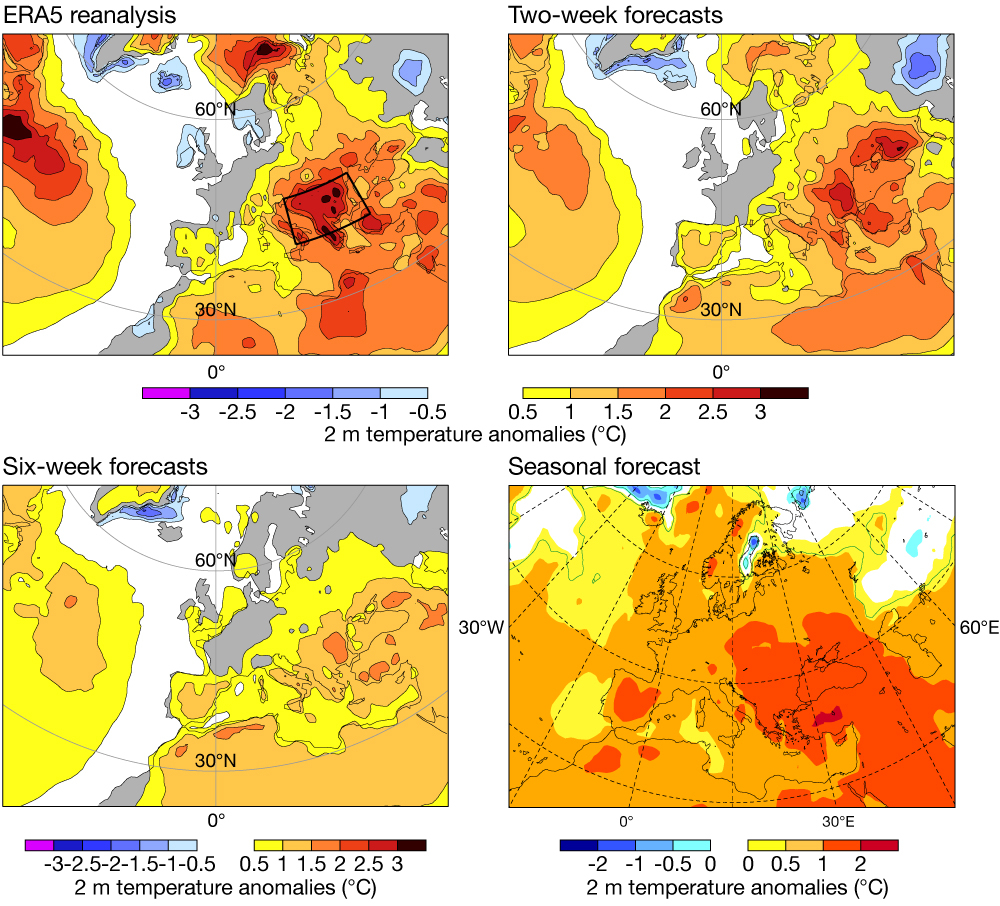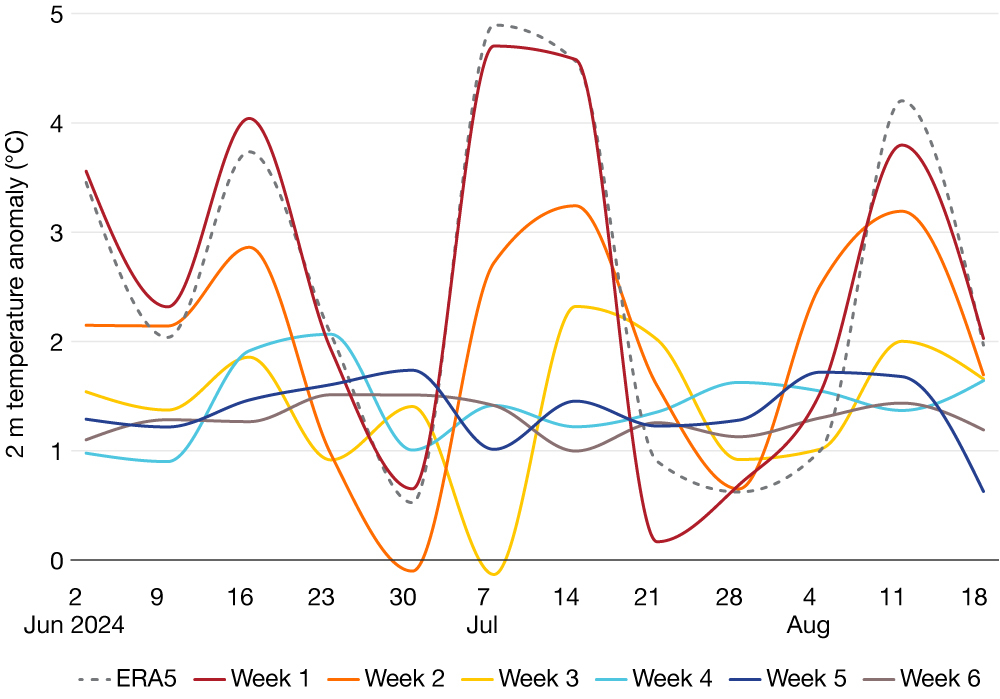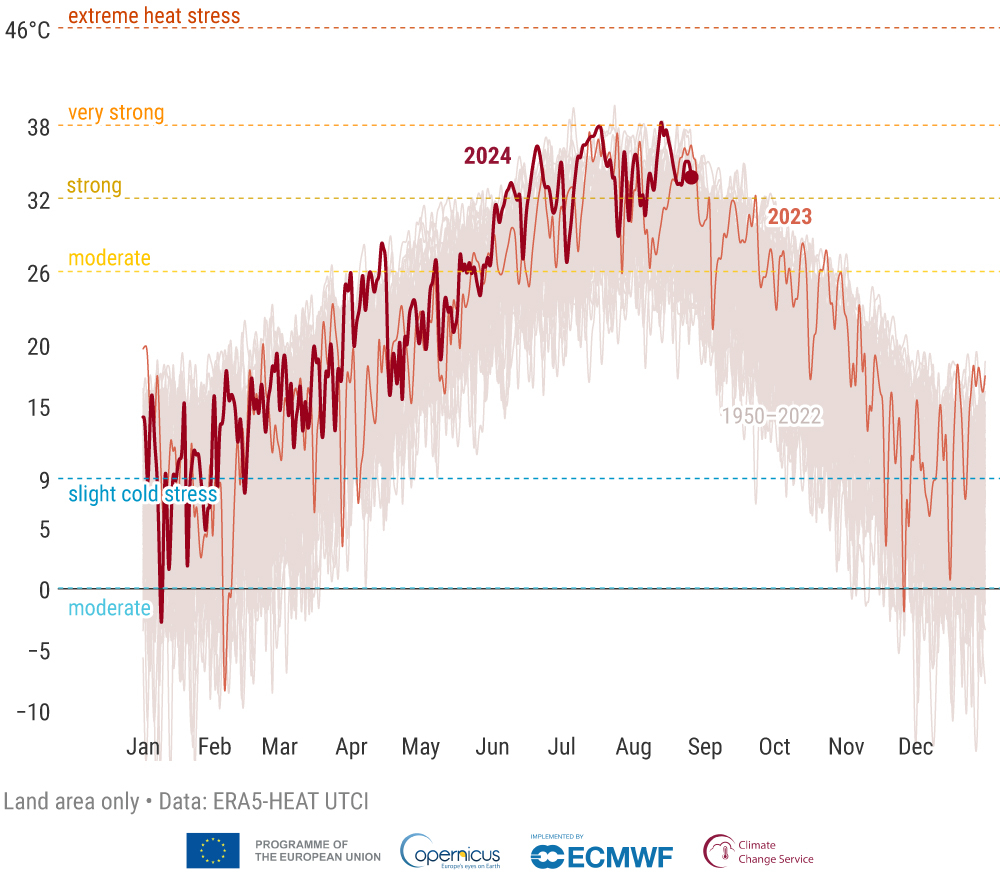Summer 2024 was the warmest on record for Europe as a whole, albeit with large variability across the continent, according to ECMWF’s ERA5 reanalysis from January 1940 to the present. While parts of western Europe saw near-average or below-average temperatures, the summer was characterised by much warmer-than-average temperatures across most of eastern Europe. As an example, Cuprija in Serbia had 65 consecutive days with a maximum temperature above 30°C. In this article, we focus on a region covering a large part of southeastern Europe (39–46°N, 15–30°E), much of which saw its warmest summer in the ERA5 record.
The sub-seasonal to seasonal scale
Here we focus on predictions at the sub-seasonal scale up to six weeks ahead, and at the seasonal scale four months ahead. Comparing composites of 2‑metre temperature weekly anomalies for 6 June to 25 August from ERA5 and ECMWF sub-seasonal forecasts with different lead times, the pattern over Europe was well captured in week‑2 forecasts (see the first image). In week‑6 forecasts the signal was weaker, as expected, but it captured the pattern, with southeastern Europe having a stronger anomaly than western Europe. However, the extension of the warm anomaly to northeastern Europe was not well captured.

The seasonal forecast from 1 May valid for June–July–August also captured a signal that southeastern Europe would have a stronger warm anomaly than western Europe. However, in the seasonal forecast, western Europe was predicted to be warmer than average, too, which was not the case in the outcome. The seasonal forecast also had a strong cold anomaly in the northern Gulf of Bothnia in the Baltic Sea, which was a remnant of the cold winter in northern Europe, but this water body became warmer than average.
Turning to the week-to-week variability for land-points in the box over southeastern Europe, we see significant variability during the summer in the ERA5 reanalysis, but all weekly means had a warm anomaly (see the second image). The largest anomalies are found for the 2nd and 3rd week of July. The week-to-week variability was very well captured in week‑1 forecasts. Week‑2 forecasts captured the variability but with a somewhat lower amplitude in the ensemble mean. The week‑3 forecasts were more problematic, especially for the onset of the hottest period in the middle of July. For the 2nd week of July, the ensemble mean from 26 June predicted a slight cold anomaly for a large part of southeastern Europe. The outcome was also warmer than the 95th percentile of the ensemble (not shown). For week‑4 to week‑6 forecasts, we find very little intra-seasonal variability, but all forecasts predicted warm anomalies of 1–2°C.

Heat stress
Associated with the warm anomalies, southeastern Europe also experienced well-above-average heat stress based on the Universal Thermal Climate Index (UTCI), which considers temperature, humidity, wind speed, sunshine and heat emitted by the surroundings, and how the human body responds to different thermal environments. It indicates weather-induced outdoor thermal stress in humans by classifying UTCI values into ten different heat and cold stress categories, with units of °C representing a ‘feels-like temperature’. An ERA5 dataset of UTCI is available on the website of the EU-funded Copernicus Climate Change Service (C3S) implemented by ECMWF (https://doi.org/10.24381/cds.553b7518).

Based on UTCI values calculated from ERA5, the UTCI anomaly in southeastern Europe for the summer as a whole was 3.3°C above average, relative to the 1991–2020 reference period. The entire period from 28 May to 31 August saw daily maximum feels-like temperatures averaged over southeastern Europe exceeding the threshold for ‘moderate heat stress’ (see the third figure). Sixty-six days during summer (June–July–August) exceeded the ‘strong heat stress’ threshold (32°C), which can be compared to an average of 29 days per summer in the period 1991–2020. The ‘very strong heat stress’ threshold (38°C) was reached on 17 July (38°C) and 13 August (38.3°C). At the peak of the heat stress on 13 August, the feels-like temperature was up to 10°C higher than the 2 m temperature in some locations, particularly in the east of the region and in southern Italy (not shown). This indicates the importance of considering other environmental factors beyond temperature for assessing the impacts of heatwaves. Operational medium-range forecasts of UTCI, alongside other thermal comfort indices such as heat index, wind chill factor and wet bulb globe temperature, will become available in Cycle 49r1 of the Integrated Forecasting System (IFS), which is to be made operational this November.
Further information on surface air temperature anomalies in Europe and the world in August 2024 can be found in the corresponding C3S climate bulletin: https://climate.copernicus.eu/surface-air-temperature-august-2024
